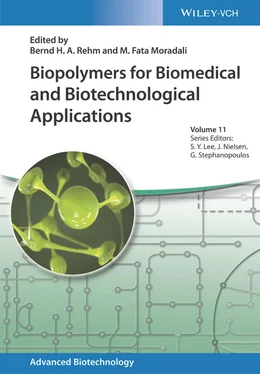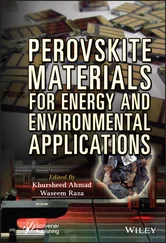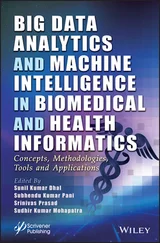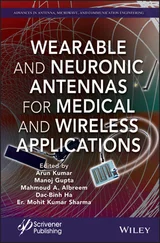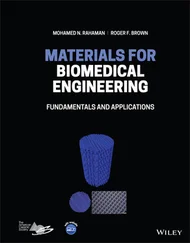Biopolymers for Biomedical and Biotechnological Applications
Здесь есть возможность читать онлайн «Biopolymers for Biomedical and Biotechnological Applications» — ознакомительный отрывок электронной книги совершенно бесплатно, а после прочтения отрывка купить полную версию. В некоторых случаях можно слушать аудио, скачать через торрент в формате fb2 и присутствует краткое содержание. Жанр: unrecognised, на английском языке. Описание произведения, (предисловие) а так же отзывы посетителей доступны на портале библиотеки ЛибКат.
- Название:Biopolymers for Biomedical and Biotechnological Applications
- Автор:
- Жанр:
- Год:неизвестен
- ISBN:нет данных
- Рейтинг книги:5 / 5. Голосов: 1
-
Избранное:Добавить в избранное
- Отзывы:
-
Ваша оценка:
- 100
- 1
- 2
- 3
- 4
- 5
Biopolymers for Biomedical and Biotechnological Applications: краткое содержание, описание и аннотация
Предлагаем к чтению аннотацию, описание, краткое содержание или предисловие (зависит от того, что написал сам автор книги «Biopolymers for Biomedical and Biotechnological Applications»). Если вы не нашли необходимую информацию о книге — напишите в комментариях, мы постараемся отыскать её.
Biopolymers for Biomedical and Biotechnological Applications — читать онлайн ознакомительный отрывок
Ниже представлен текст книги, разбитый по страницам. Система сохранения места последней прочитанной страницы, позволяет с удобством читать онлайн бесплатно книгу «Biopolymers for Biomedical and Biotechnological Applications», без необходимости каждый раз заново искать на чём Вы остановились. Поставьте закладку, и сможете в любой момент перейти на страницу, на которой закончили чтение.
Интервал:
Закладка:
| Polysaccharide | Nanoparticles | Possible applications | References |
|---|---|---|---|
| Hyaluronan | Fe 3O 4 | Contrast agents for MRI; drug delivery systems | [169] |
| Dextran | Fe 3O 4 | Cellular MRI and fluorescence imaging; drug delivery systems | [169] |
| Au 0 | Anticancer agent | [171] | |
| Ag 0 | Sensor for cysteine detection; antibacterial and antifungal agent | [169] | |
| Chitosan | Fe 3O 4 | Drug delivery systems | [169] |
| Cu 0/Fe 0/CdS | Degradation of Congo red and heavy metals in water (e.g. Cr(VI)) | [170] | |
| Fe 3O 4 | Contrast agents for MRI; hyperthermia agent | [168] | |
| Xanthan gum | Au 0 | Drug delivery systems; anticancer therapy | [171] |
| Ag 0 | Antibacterial and catalytic agent | [173] | |
| Pd/Fe | Soil remediation | [171] | |
| Gellan Gum | Au 0 | Drug delivery systems; anticancer agent | [171] |
| Ag 0 | Antibacterial and topical treatment | ||
| Fe 3O 4 | Drug delivery systems; anticancer agent |
MRI, magnetic resonance imaging.
Microbial polysaccharides show variability, versatility, stability, biocompatibility, and biodegradability. Adding to this, their important feature to act as a thickening, stabilizing, or binding agent makes them suitable to a wide range of applications, from food industry to pharmaceutical, medical, and cosmetic products. Moreover, since some of these biopolymers can form structured materials (such as gels and films), they could be used as matrices for the development of bionanocomposites with incorporated nanoparticles (Au 0, Ag 0, Fe 3O 4) for distinct applications in the biomedical field (anticancer, antibacterial, or hyperthermia agent, respectively). Polysaccharide‐based nanomaterials are an excellent source for nanotechnological applications in food, pharmaceutical, biomedicine, and cosmetic industries.
2.6 Bioactive Polysaccharides from Microalgae: An Emerging Area
Microalgae (including cyanobacteria) can use CO 2as carbon source and incorporate it in complex organic molecules, accounting for nearly half of CO 2capture by photosynthetic organisms annually. Their growth requirements are quite simple: a seawater medium supplemented with a source of nitrogen (apart from nitrogen‐fixing microorganisms), phosphate, iron, magnesium, calcium, and other minor salts [174]. As photosynthetic organisms, no carbon source is added to the cultivation medium; thus less wastewater is generated at the end of the process. Furthermore, algae cultivation is possible with non‐potable water and using the sunlight, which contributes to a more ecological and economical process [68].
Currently, there are more than 30 000 known species of microalgae [175] that are present in different evolutionary lines and have contrasting ecological requirements, meaning this group has an enormous metabolic diversity and great potential for biotechnology. In fact, microalgae production is an emergent market with an expected yearly growth of 10% [6]. Besides the use of biomass as feed in aquaculture and livestock production [176,177], microalgae are the source of high‐value products, such as natural pigments (e.g. β‐carotene and astaxanthin), polyunsaturated fatty acids, proteins, and antioxidants, that are commercialized mainly for the nutraceutical [178] and skin care [179] industries. Moreover, microalgae are increasingly investigated as a new sustainable and environmentally friendly alternative to fossil fuel resources, since they accumulate high amounts of lipids and carbohydrates that can be used as feedstock for biofuel production [180,181]. However, almost all commercial microalgae products are obtained from the biomass, and only recently their relevance as producers of valuable polysaccharides has started to be considered.
2.6.1 Polysaccharide‐Producing Microalgae
Microalgae are a large group of photosynthetic unicellular or multicellular organisms, which includes both prokaryotic (Cyanophyta, i.e. cyanobacteria/blue‐green algae) and eukaryotic organisms, belonging to the phyla Chlorophyta (green algae), Rhodophyta (red algae), Chrysophyta (diatoms), and Pyrrophyta (dinoflagellates). Polysaccharide‐producing microalgae are found in all microalgae phyllo (Table 2.3), and their EPS are characterized by complex chemical structures generally with a high diversity of sugar monomers in the same macromolecule, including rare sugars such as fucose, rhamnose, and ribose, which are known to confer the biopolymers' biological activity [6]. Examples include the EPS secreted by Arthrospira platensis [43], Porphyridium marinum [40], and Rhodella sp. [46]. Fructose was also found in EPS secreted by Dunaliella salina [72]. Of notice is the presence of methyl‐derivate sugars (e.g. Dictyosphaerium chlorelloides ) [71] and uronic acids, mainly glucuronic and galacturonic acid [182,184]. As can be seen in Table 2.3, sulfate groups are also found within algal EPS (sEPS), which further contributes to their unique properties [6].
Table 2.3Polysaccharide‐producing microalgae and polysaccharide characterization.
| Organism | Sugar composition | Other | Mw (Da) | Bioactivity and applications | References |
|---|---|---|---|---|---|
| Rhodophyta | |||||
| Porphyridium sp. | Xyl, Gal, Glc, GlcA | Sulf | 2.4 × 10 5to 1.8 × 10 6 | Anti‐inflammatory, antioxidant, hypocholesterolemic, biolubricant | |
| Porphyridium purpureum | Gal, Xyl, Glc, GlcA, Fuc | Sulf | n.a. | Antiviral, antimicrosporidian activity | [42,43] |
| Porphyridium cruentum | Gal, Glc, Ara, Man, Fuc, Xyl, Rha | Protein, sulf, UA | n.a. | Antibacterial, antiviral, antiglycemic | [44,45] |
| Rhodella sp. | Xyl, Gal, Glc, Rha, Ara, GlcA | Sulf | n.a. | n.a. | [46] |
| Rhodella maculate | Gal, Xyl, GlcA, Rha, Ara, Glc | Protein, sulf | n.a. | n.a. | [43] |
| Rhodella reticulata | n.a. | n.a. | n.a. | Antioxidant | [47] |
| Rhodella violacea | Gal, Xyl, Glc, GlcA, Rha, Ara | Protein, sulf | n.a. | n.a. | [43] |
| Pyrrophyta (dinoflagellates) | |||||
| Cochlodinium polykrikoides | Man, Gal, Glc | UA, sulf | n.a. | Antiviral | [48] |
| Gymnodinium sp. | Gal | Sulf, lactic acid | 1.3 × 10 6 | Antitumor activity | [49,50] |
| Gyrodinium impudicum | Gal | Sulf, UA | 1.9 × 10 7 | Immunomodulatory and antitumor activity | |
| Cyanophyta ( cyanobacteria ) | |||||
| Aphanothece halophytica | Glc, Fuc, Man, Ara, GlcA | — | 2.0 × 10 6 | Adjuvant activity, antiviral, anticancer | |
| Anabaena augstmalis | Glc, Gal, Man, Xyl, Fuc, Rha, GalN, GlcN, GalA, GlcA | Sulf | n.a. | n.a. | [58] |
| Arthrospira platensis | Rha, Gal, Glc, Fuc, Xyl | Sulf | n.a. | Antiviral, antibacterial, antioxidant, anticoagulant, skin repair | [42, 59–63] |
| Microcoleus vaginatus | Glc, Gal, Ara, Xyl, Man, Rha, Fuc, GalA, GluA | Protein | n.a. | [64] | |
| Nostoc sp. | Glc, Gal, Xyl, Rha, Man, GalA, GlcA | Protein | n.a. | n.a. | [65] |
| Nostoc flagelliforme | Glc, Xyl, GlcA, Gal | — | n.a. | Antiviral | [66,67] |
| Phormidium autumnale | Rha, Rib, Man, Glc, Fuc, Gal, Ara, GalA, GlcA | Sulf | n.a. | n.a. | [58] |
| Synechocystis aquatilis | Fuc, Glc, Rha, Xyl, Man, GlcN, GalA, GlcA | Sulf | n.a. | n.a. | [58] |
| Chlorophyta | |||||
| Chlamydomonas reinhardtii | GalA, Rib, Ara, Xyl, Glu, Gal, Rha | Pyr | 2.3 × 10 5 | Antioxidant | [68] |
| Chlorella stigmatophora | Glc, GlcA, Xyl, Rib/Fuc | Sulf, UA | 22 × 10 3 | Anti‐inflammatory, immunomodulatory (immunosuppressant) | [69] |
| Cyanobacterium aponinum | GalA, Fuc, 3‐OMe‐GalA, Glc, Ara, Gal, Man, Rha, 4‐OMe‐GlcA | — | 1.06 × 10 6 | Immunomodulatory | [70] |
| Dictyosphaerium chlorelloides | Gal, Me‐Gal, Rha, Man, Me‐hexose, Glc, Me‐Glc, Xyl, Me‐Xyl, Ara | Protein | 9.6 × 10 5 | Antiproliferative immunostimulation of pro‐ and anti‐inflammatory cytokines | [71] |
| Dunaliella salina | Glc, Gal, Fru, Xyl | — | n.a. | n.a. | [72] |
| Dunaliella tertiolecta | Glc | — | n.a. | n.a. | [73] |
| Graesiella sp. | Fuc, Gal, Ara, Glc, Man, Xyl, Rib, Rha | Sulf, UA, protein | n.a. | Antioxidant, antiproliferative | [74] |
| Haematococcus pluvialis | Rib, Ara, Man, Glc | Acetyl and amino groups | 23 × 10 6 | Antiaging, immunomodulatory | [75] |
| Parachlorella kessleri | Ara, Rha, Xyl, Man, Gal | — | 65 × 10 3 | Antitumor, immunomodulatory | [76] |
| Chromophyta (diatoms) | |||||
| Navicula directa | Fuc, Xyl, Gal, Man, Rha, Glc, GlcA | Protein, sulf | 2.2 × 10 5 | Antiviral | [77] |
| Phaeodactylum tricornutum | Glc, GlcA, Man | Sulf, UA | 27 to 449 × 10 3 | Anti‐inflammatory, immunomodulatory (immunostimulatory) | [69] |
n.a., not available; Ara, arabinose; Fuc, fucose; Fru, fructose; Gal, galactose; GalA, galacturonic acid; GalN, galactosamine; Glc, glucose; GlcA, glucuronic acid; GlcN, glucosamine; Man, mannose; Me, methyl derivatives; Pyr, pyruvate; Rha, rhamnose; Rib, ribose; Sulf, sulfate; UA, uronic acids; Xyl, xylose.
Читать дальшеИнтервал:
Закладка:
Похожие книги на «Biopolymers for Biomedical and Biotechnological Applications»
Представляем Вашему вниманию похожие книги на «Biopolymers for Biomedical and Biotechnological Applications» списком для выбора. Мы отобрали схожую по названию и смыслу литературу в надежде предоставить читателям больше вариантов отыскать новые, интересные, ещё непрочитанные произведения.
Обсуждение, отзывы о книге «Biopolymers for Biomedical and Biotechnological Applications» и просто собственные мнения читателей. Оставьте ваши комментарии, напишите, что Вы думаете о произведении, его смысле или главных героях. Укажите что конкретно понравилось, а что нет, и почему Вы так считаете.
